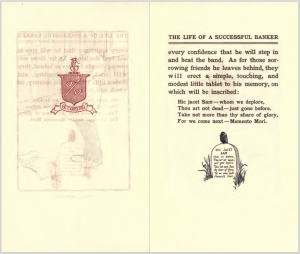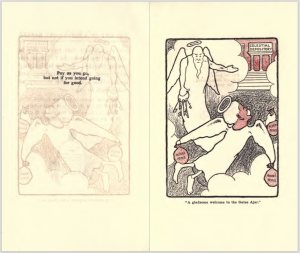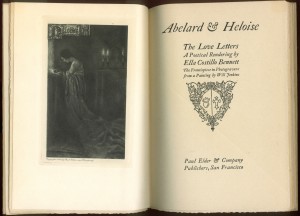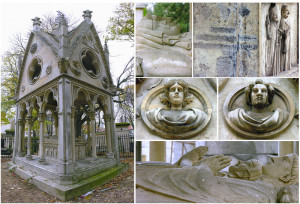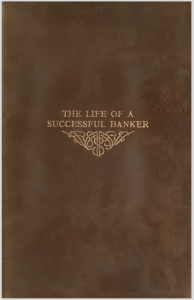
The Life of a Successful Banker (1905) is humorous short story, purporting to describe a young man’s journey from humble beginnings in North Carolina to become a “great financier” at the First Rational Bank in San Francisco. The author fancifully claims to have gone from the dry-goods business to the “wet-goods” business (alcohol) to the back door of a San Francisco bank on a dark and stormy night (the safe was already empty). My favorite bit is the author’s own proposed epitaph:
Hic jacet Sam, who we deplore / Thou art not dead, just gone before / Take not more than thy share of glory / For we come next — Memento Mori
The title page notes the author as “His Boswell,” a reference to James Boswell’s famous biography of Samuel Johnson. However, the author, as well as title character, is Samuel Green Murphy (1837-1926), the very successful President of the First National Bank at the corner of Bush & Sansome. He was born in North Carolina and served in the Confederate Army before coming to California.
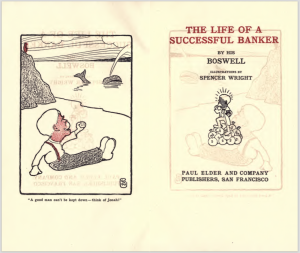
The Life of a Successful Banker is perhaps the most memorable of all the vanity publications published by Elder at the Tomoye Press. Only fifty-five copies of this little book were produced, surely for private circulation amongst Murphy’s friends. At barely 700 words, the text would fill only two typed pages, but with a pleasing design on small paper and interspersed with amusing drawings by Spencer Wright, the work becomes a 32-page booklet. And what the book lacks in substance, it makes up for in intrigue of the Rich and Famous.
Several notable things happened to Samuel Murphy in 1905, the year this booklet was published. The first was a reconciliation with his daughter Adelaide (1882–ca. 1955), who had in July 1902 married against his wishes. Though her fiancé was rich—indeed, John Cabell Breckinridge (1879–1914) was the grandson of John Cabell Breckinridge (US vice-president under Millard Fillmore) and son of John W. Breckinridge, the first President of Wells Fargo Bank—Samuel Murphy was vehemently opposed to Adelaide’s elopement and disowned her. The whole affair was front-page fodder for the local newspapers. “I had a daughter once,” he was quoted as saying. “If she is married, she is dead.”

Nor did the notoriety end there. Eight months later, while the newlyweds were in Paris, John fell from a second-story balcony of the Hotel d’Albe on the Champs Elysées. He was lucky to escape with only bruises, but that was just the beginning. Three months later, in May 1903, both Adelaide and John’s mother were petitioning the French courts for legal control of John (I suppose today we would say “medical power of attorney”) due to his incompetency. The courts upheld Adelaide’s claim, and John was placed in a sanitarium. The San Francisco newspapers duly reported on all the twists and turns of the Murphy clan. What they did not report during all the hubbub, but which would surely be reported today, was that Adelaide was six months pregnant with their son John Cabell Breckinridge, Jr., who was born on Aug 5th.
In December 1905, Samuel Murphy received word that Adelaide herself was gravely ill. He decided then to lay aside his grievances and travel to France. “We had a misunderstanding once, but that is all over now,” he told the San Francisco Call. “I shall go to her if she needs me.” Happily, Adelaide recovered from her illness.

The other notable event in Samuel Murphy’s life in 1905 was his donation of $20,000 (more than $500,000 in today’s money) for the construction of a windmill in Golden Gate Park.
The creation of Golden Gate Park in the 1870s and 1880s from a long stretch of sand dunes was a tremendous feat of landscape design, but the new plantings required a great deal of water. In 1902, the San Francisco Park Commission authorized the construction of two windmills to pump groundwater for park irrigation, to avoid purchasing water at exorbitant costs from the Spring Valley Water Company. The windmills would be built on the western edge of the park, just off Ocean Beach, in order to take advantage of the winds that blow almost every afternoon. The Dutch Windmill was completed in 1903 and pumped 30,000 gallons per hour. The Murphy Windmill was completed in 1908 and pumped an additional 40,000 gallons per hour.
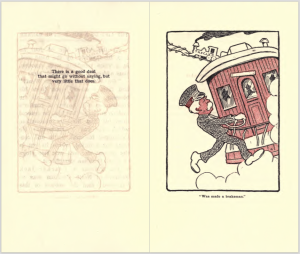
The Murphy Windmill had an additional fifteen minutes of fame when it appeared in the 1915 Charlie Chaplin movie A Jitney Elopement. (You can watch the movie here; the windmill appears at 21:08.) Not long afterwards, electric pumps (which could pump when it wasn’t windy) made the windmills obsolete. They fell into disrepair, and probably spent more decades without their massive spars and sails than with them (this is how I remember the windmills; see the middle photograph above). Restoration work on the Murphy Windmill began in 2002 and was completed in 2012, and today the blades can often been seen turning in the wind.
How did the Murphy family turn out in the end? I’m glad you asked:
- After the events of 1905, Samuel G. Murphy seems to disappear from the historical record. He died in Helena, Montana in 1926 at the age of 89.
- Adelaide Murphy Breckinridge apparently spent the rest of her life abroad. She lived at least until 1955, when she is known to have sued her son John Brekinridge Jr. for support. It’s unknown how she ended up in financial straits, given that both her father and husband were very wealthy men.
- John C. Breckinridge Sr. continued to show signs of mental illness, and was committed to an asylum in France. His marriage to Adelaide was annulled in 1914, and apparently John died soon afterwards.
- John C. “Bunny” Breckinridge, Jr. (1903-1996), Adelaide and John Sr.’s son, had a remarkably colorful life. Educated at Eton and Oxford in England, he lived for many years in Paris before coming to the United States. He was openly gay in a time when it was rare to do so, and often performed onstage as a drag queen. He is known among film buffs for his one and only movie role, that of “The Ruler” in the 1959 cult favorite Plan 9 From Outer Space. (I am not making this up.) Shortly thereafter, he spent a year in prison on sex offences, but enjoyed a revival in popularity during the 1960s, in part for his knowledge of gay history.
